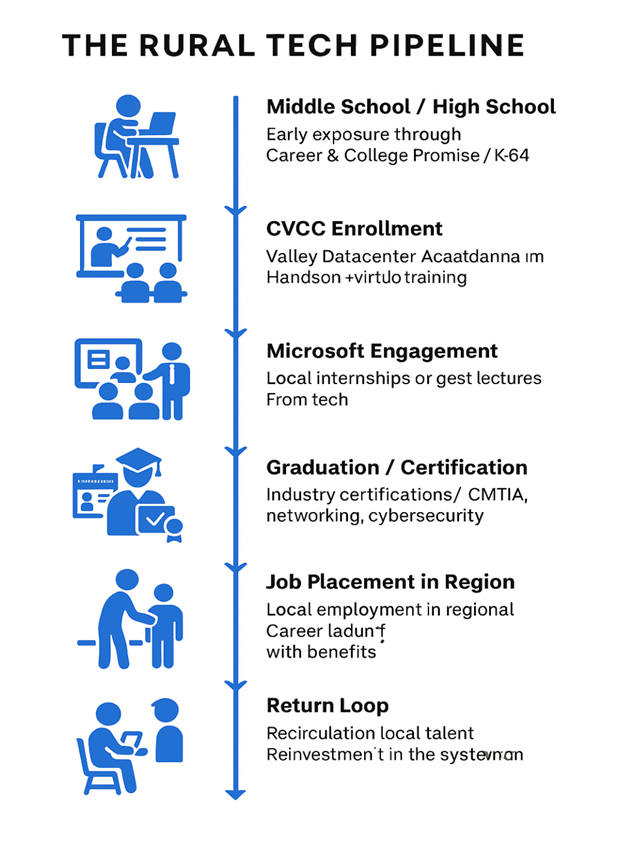The Foothills Corridor - Chapter 11 - The Valley Datacenter Academy and Microsoft’s Pivot
Chapter 11
The Valley Datacenter Academy and Microsoft’s Pivot
Not long ago, the idea of high-tech careers rooted in the Foothills Corridor seemed like science fiction. But thanks to a rare alignment between a global tech giant and a forward-thinking local institution, that future has arrived—quietly, methodically, and without fanfare. The Valley Datacenter Academy, launched in partnership with Catawba Valley Community College (CVCC) and Microsoft, is one of the most promising signs that the Foothills isn’t just surviving its past—it’s training for its future.
The Microsoft Moment
Microsoft’s decision to invest in data centers across Catawba County signaled a major shift in the region’s economic potential. Traditionally viewed as a backwater for tech, the Foothills offered two critical advantages: cheap land and underutilized infrastructure, especially in rural areas with industrial zoning and access to utilities.
But data centers don’t just require fiber and concrete—they need talent. Skilled, reliable, trained technicians to run and maintain the complex systems inside. Microsoft knew it couldn’t fly in workers indefinitely. It needed local capacity.
That’s where CVCC came in.
Building a Pipeline from the Ground Up
Instead of offering generic IT training, CVCC worked directly with Microsoft to develop a curriculum tailored to the real needs of datacenter operations. Students learn everything from server management and network troubleshooting to critical facility protocols, safety, and diagnostics.
This isn’t about coding apps in Silicon Valley—it’s about running the hardware behind the cloud. And it’s creating a new class of blue-collar tech worker right here in the Foothills.
The Valley Datacenter Academy provides:
· Hands-on training using industry-standard equipment
· Fast-track certifications aligned with hiring timelines
· Opportunities for placement directly into Microsoft or its subcontractors
· A clear, accessible path to middle-class wages without a four-year degree
Why It Matters
The Foothills Corridor has long been haunted by a false binary: you either worked with your hands in manufacturing or you left town for something better. The Valley Datacenter Academy is blowing up that myth.
It’s proving that the region can be a home for technical skill, digital infrastructure, and modern jobs—without abandoning its working-class roots. This isn’t about gentrification or “brain drain” reversal. It’s about upskilling the people who already live here and connecting them to a future that previously passed them by.
It’s also redefining the role of community colleges. CVCC isn’t just a place to get a degree—it’s a strategic anchor in a tech transition, offering employers real value while serving local residents with real outcomes.
Early Wins, Long-Term Vision
Enrollment numbers are growing. Job placements are happening. And perhaps most critically, the collaboration between CVCC and Microsoft has become a model for other counties looking to partner with industry without selling out their communities.
But the Valley Datacenter Academy is still in early stages. The key now is scaling this model, adapting it to other sectors (like green energy or logistics), and expanding access across underrepresented communities.
If that happens, this program won’t just be a success—it’ll be a blueprint.
The Bigger Pivot
For Microsoft, this wasn’t just a real estate decision. It was a shift in how the company views its role in regional development. Rather than parachuting in and extracting talent, it invested in building it. That’s the kind of pivot more major employers need to make—not just in the Foothills, but across rural America.
And for the Foothills Corridor, the pivot is just as significant. For decades, the region was treated as a place to manufacture furniture, textiles, and hard goods. Now, it’s becoming a place to run the digital backbone of the global economy. The goods may be different—but the potential is just as real.
Datacenters bring investment and prestige, but they don't bring dense employment. Compared to manufacturing plants or business parks, the number of permanent jobs per acre is low—meaning datacenters alone can’t rebuild a middle-class economy.
The Valley Datacenter Academy is one of the clearest signs yet that the Foothills is not waiting to be rescued. It’s building a future—one server rack, one student, one signal at a time. It’s not just workforce development—it’s rural proof-of-concept for blue-collar tech careers.


